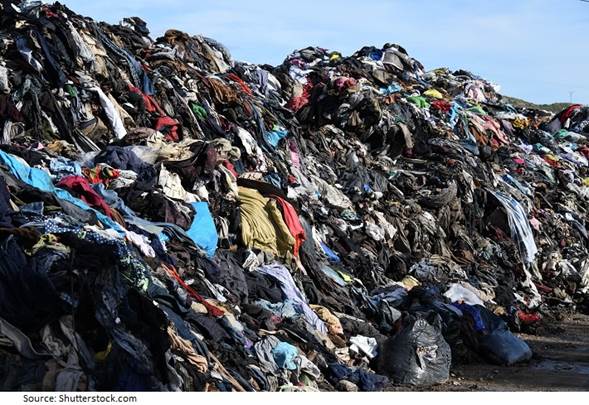As one of the biggest industries, fashion is generating an estimated $1.5 trillion in a year, sustaining a global workforce of 3.4 billion but at the same time, it is also known as the second-largest polluted industry in the world. For a long time, the apparel manufacturing companies, and fast fashion brands have produced large quantities of apparel, months in advance with no certainty of how well they will sell. Consequently, there has been some disastrous impact on the environment like Chile’s Atacama, labelled as the driest desert, is increasingly being affected by pollution due to the fast fashion mania.

With social media powering trends and influencing our livelihoods, we are living in the ‘insta-age’ of technology. On the flip side, the younger generation is more aware of environmental issues, and they want environment-friendly products customised to their needs. As consumer’s real lives become increasingly intertwined with the digital world, so designers, apparel brands and manufacturers must embrace technologies to push their limits. Let us discuss some of the cutting-edge technologies that might change the fashion world with sustainable design solutions.
AI for Trend Spotting and Data Analysis:
Though fashion may be extremely dynamic and ever evolving, it’s the changing trends that drive the industry. In this backdrop, AI-powered data analysis and insights are shaping the fashion universe and diverse careers.
For instance, Tommy Hilfiger had a collaboration with IBM and Fashion Institute of Technology (FIT), New York to develop an artificial intelligence system to determine the kind of data required for optimising the production, and to relook at sales with reduced cost and waste.
Robotics for Automated Manufacturing:
As we usher in the 4th industrial revolution of automation through robotics, artificial intelligence (AI), machine learning (ML) and cognitive computing will disrupt the garment manufacturing industry. The companies like SoftWear Automation, Inc. is introducing automated sewing machine, also known as Lowry. This fully automated sewbot reduces the need for sewing labourers. When a human sewing line produces 669 t-shirts in eight hours, compared to the robots at 1142 t-shirts. The emerging technologies for automation and data analytics have direct impact on mass manufacturing of apparel and shifting the consumer needs to just-in-time production. The result is a reduced level of overstock and less clothing that ends in landfills. To increase the supply chain efficiency, Amazon in 2021 won a patent for an on-demand apparel manufacturing system that would stitch customer’s clothing after the order was placed.
AR /VR Technology and Virtual Fashion Stores:

The technology of augmented and virtual reality in the fashion industry can turn out to be the best technology introduced so far and in the near future, it will ease the online shopping procedure a lot. Apart from providing customers with the freedom to make the right choice while purchasing a garment, it helps them with virtual try-on 3D. Most leading brands are currently working on 3D avatars also called virtual human and virtual mirrors that will help customers to try different options available and at the same time to check the outfit in terms of styling, correct fit and fall from different angles.
3D Design, Printing and Mass Customisation:
With the new 3D rendering technologies like CLO3D, TG3D, EFI Optitex etc, the designers and brands can edit designs in the moment and instantly review changes. Such technology will help industry to improve quality by checking silhouette and fit during the design development process, making all necessary changes in real-time. The use of 3D scanners along with such technology is taking care of accurate body measurements without human errors. Also, 3D printing has been used in the industry for prototyping and it reduces fabric waste by about 35 per cent. It is exciting to see, how a brand like Adidas is offering 3D printed shoes to the consumers and apparel brand like the Ministry of Supply provides an in-store 3D printer to create customised knitwear on the spot.
Digital Factories:
New technology is converting mass manufacturing production units into digital factories. The technology like manufacturing CRM helps manufacturers to manage product sales and improve customer relationship, all from one platform. This software allows manufacturers to close deals and organise customer data more efficiently. Software like ‘Techpacker’ makes it easy for factory owners to communicate with clients online as well as track product development progress. Furthermore, it helps to receive teck pack with good quality images and translate files into destination languages.
Blockchain:
When everything becomes automated through technology, the risk of being hacked increases and it adds to cybercrime. To counter this, blockchain technology aims to bring transparency, efficiency, and, most importantly, traceability in garment industry. Where the raw materials for a garment came from, their carbon footprint on the environment, who designed, where it was manufactured, and who owned it before them. It makes the whole supply chain more transparent and reliable.
For example, MCQ a fashion label that was launched by Alexander McQueen provides a useful case study. The label harnesses blockchain and IoT to demonstrate its sustainability commitments and unites customers around a shared passion that is sustainability luxury fashion.
Work Ethics and Work Environment:
For a long time, the fashion industry has survived by sourcing cheap labourers from different parts of the world. The industry was functioning by following a fragmented production model to make the process more cost-effective but always compromising on work ethics. Although laws were existing to protect workers and their rights, but hardly anything was done on effective implementation or driving awareness.
But lately many of the global brands are expressing their concern on such issues and trying to make agreements with the government, suppliers, and NGOs to provide workers with a fair living wage and decent working conditions. The use of new online-based technologies is offering immense possibilities to understand and address such issues.
For example, ‘Labour Exploitation Accountability Hub’ is offering much of information on relevant laws, labour exploitation in different countries, and tools to fight back. Another platform called ‘Focus on Labour Exploitation’ provides information about local laws that can help in protecting workers.
I believe that technology is the by-product of human revolution. It provides a greater context to amplify our potential, enrich our lives, widen our knowledge, and expand our freedom. When used mindfully, technology becomes more human centric and can create a better future.
Prasanna Baruah is an Associate Dean, Fashion & Textile, School of Fashion at Pearl Academy.









Comments